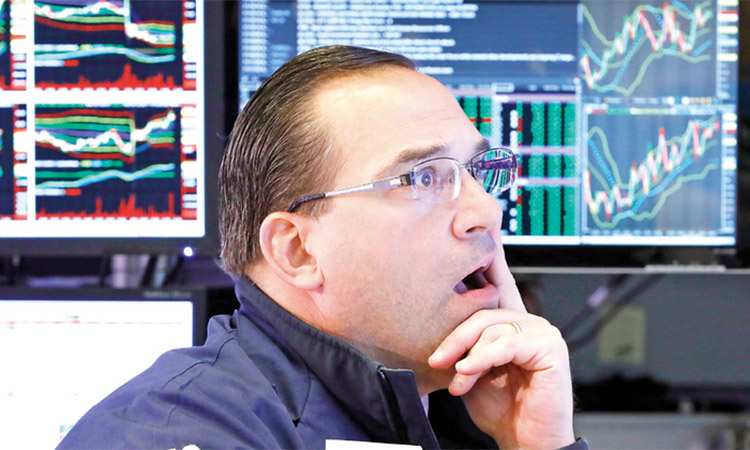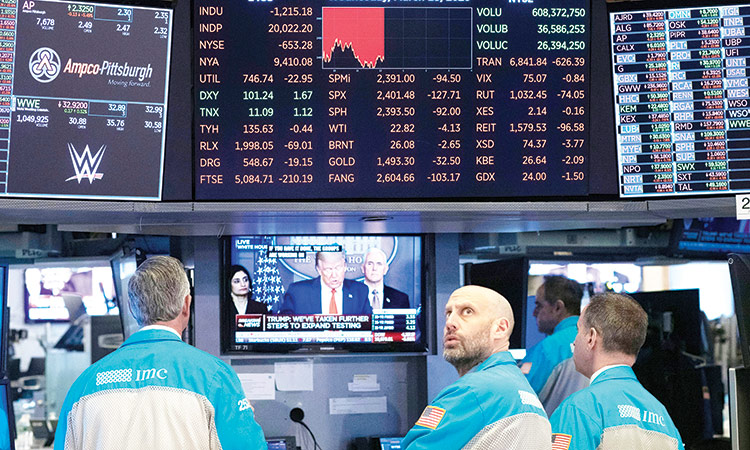Global stocks tick higher, bond yields drop ahead of Fed minutes

A trader works on the floor of the New York Stock Exchange.
Meanwhile, oil prices were little changed. The MSCI All World stock index was last up 0.21% on Wednesday, after rising 1% in the previous session.
Futures for the S&P 500 were up 0.26% after the stock index climbed 0.52% on Tuesday. Nasdaq and Dow Jones futures rose 0.4% and 0.27% respectively.
Europe’s continent-wide STOXX 600 index was 0.33% higher in early trading after surging 1.96% in the previous session. French luxury company LVMH fell 5.9% after it posted results that showed its sales growth slowed.
“I’m expecting the market to remain in wait-and-see mode throughout the day because we have the Fed minutes tonight” said Florian Ielpo, head of macro at Lombard Odier Investment Managers.
Global stocks, which had been on the slide since early August, have rallied for the last few sessions. Investors have shifted back to equities as US. bond yields - which underpin borrowing costs around the world - have dropped from their highest levels since 2007 as Fed officials have suggested rate hikes are over.
Bond yields, which move inversely to prices, tumbled again on Wednesday. The yield on the global benchmark 10-year U.S. Treasury note was last down 8 basis points at 4.573%, sharply below last week’s peak of 4.887%, which was the highest level since 2007.
“In a matter of days these are massive moves,” said Arthur van Slooten, global asset allocation strategist at Societe Generale.
“The fall in bond yields has been driven by a fall in oil prices, which reflects economic concerns, as well as the Fed hinting they won’t raise rates again.”
Atlanta Fed President Raphael Bostic was applauded when he told a room full of bankers in Nashville on Tuesday: “I actually don’t think we need to increase rates anymore.”
Meanwhile, oil prices have fallen from their recent peaks and remain relatively steady despite the prospect of conflict in the Middle East spilling over from Israel and Gaza.
Brent crude oil futures traded at $87.78 a barrel, down 0.62% on the day. They rose to $89 a barrel on Monday after Hamas’ attack, but remain around 11% lower than the $97.69 level reached in late September.
The minutes from the Fed’s September meeting, when it chose to hold interest rates at 5.25% to 5.5% but signalled more hikes might be on the way, are due to be released at 1800 GMT (2 p.m. ET). Investors will scrutinise them for hints about the economic outlook and where U.S. rates are heading.
The US wholesale prices rose last month at the fastest pace since April, suggesting that inflationary pressures remain despite a year and a half of higher interest rates.
The Labor Department reported Wednesday that its producer price index - which measures inflation before it hits consumers - climbed 2.2% from a year earlier. That was up from a 2% uptick in August.
On a month-to-month basis, producer prices rose 0.5% from August to September, down from 0.7% from July to August.
Excluding volatile food and energy prices, so-called core inflation rose 2.7% in September from a year earlier and 0.3% from August. The Federal Reserve and many outside economists pay particular attention to core prices as a good signal of where inflation might be headed.
Wholesale prices have been rising more slowly than consumer prices, raising hopes that inflation may continue to ease as producer costs make their way to the consumer. But Wednesday’s numbers, driven by an uptick in the price of goods, came in higher last month than economists had expected. Wholesale food prices rose 0.9% last month from August after tumbling 0.5% from July to August.
Last year, inflation reached highs not seen in four decades, prompting the Fed to raise interest rates aggressively. The central bank has boosted its benchmark rate 11 times since March 2022. Those higher borrowing costs have helped cool inflation and slow a still-solid job market.
There are growing expectations that the Fed may decide to leave interest rates alone for the rest of the year. On Monday, two Fed officials suggested that the central bank may leave its key rate unchanged at its next meeting in three weeks, helping touch off a rally in bonds and stocks.
Rubeela Farooqi, chief U.S. economist at High Frequency Economics, said last month’s higher producer prices “likely do not change the outlook for Fed policy. Our baseline remains that rates are at a peak. For the Fed, geopolitical developments will be an additional risk factor which will likely keep policymakers proceeding cautiously going forward.”
In the meantime, the economy has remained sturdier than expected. Optimism is rising that the Fed may pull off a ‘’soft landing’’ - raising rates just enough to tame inflation without tipping the economy into a deep recession







